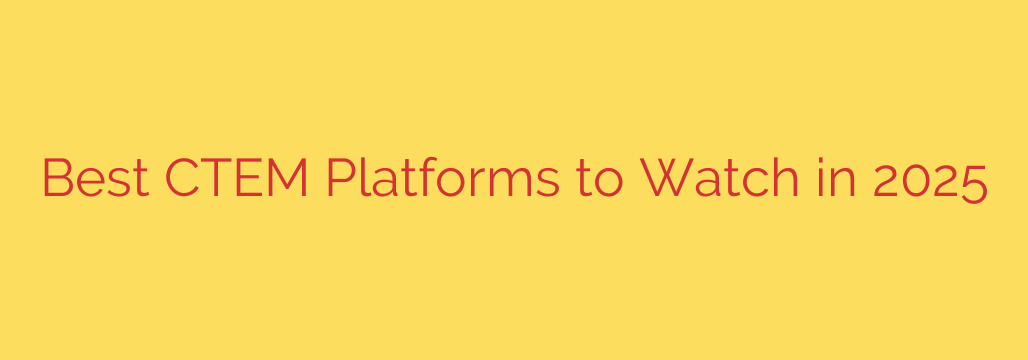
Navigating the Future of Cybersecurity: A Guide to CTEM in 2025
The digital landscape is expanding at an unprecedented rate. With the rise of cloud infrastructure, remote work, and interconnected devices, organizations face a rapidly growing and increasingly complex attack surface. Traditional security methods, focused on periodic scans and siloed vulnerability reports, are struggling to keep pace, leaving dangerous gaps for attackers to exploit.
To address this challenge, a more proactive and integrated approach is essential. Enter Continuous Threat Exposure Management (CTEM), a strategic framework designed to give organizations a constant, attacker-centric view of their security posture. Rather than just reacting to threats, CTEM empowers security teams to continuously identify, prioritize, and remediate the exposures that matter most.
Beyond Traditional Vulnerability Management
For years, security programs have relied on vulnerability management tools that generate long lists of potential weaknesses. The problem? These lists often lack context. Security and IT teams are left overwhelmed, struggling to determine which of the thousands of vulnerabilities pose a genuine, immediate threat to critical business operations.
CTEM represents a fundamental shift away from this reactive model. It’s not just about finding flaws; it’s about understanding their business impact and potential for exploitation. By thinking like an attacker, organizations can cut through the noise and focus their resources on fixing the pathways that lead to their most valuable assets.
The Core Pillars of a CTEM Program
A mature CTEM program operates as a continuous cycle, integrating different security functions into a cohesive strategy. This cycle is typically built on five key pillars:
Scoping: This foundational step involves defining the scope of your security efforts. It’s not just about cataloging every server and laptop. It’s about identifying critical assets and high-value business systems—the “crown jewels” that would cause the most damage if compromised.
Discovery: Once you know what to protect, you need to discover all the potential exposures related to those assets. This includes a comprehensive inventory of your entire attack surface, both internal and external, covering everything from known software vulnerabilities to misconfigurations in the cloud and exposed credentials.
Prioritization: This is where CTEM truly shines. Instead of using a simple “critical” or “high” severity rating, modern platforms analyze exposures based on multiple factors. This includes attack path analysis, which maps out how an attacker could chain together multiple, lower-risk vulnerabilities to reach a critical asset. Prioritization is driven by real-world business risk, not just technical severity scores.
Validation: How do you know if a prioritized threat is actually exploitable in your specific environment? The validation stage uses tools like Breach and Attack Simulation (BAS) and automated penetration testing to safely test and confirm the viability of attack paths. This provides concrete proof that a vulnerability needs immediate attention and helps eliminate false positives.
Mobilization: The final step is to ensure that findings are communicated effectively to the right teams for remediation. A strong CTEM platform facilitates this with clear reporting, automated ticketing workflows, and cross-team collaboration tools. The goal is to streamline the handoff between security and IT operations, ensuring fixes are implemented quickly and their effectiveness is verified.
Key Features to Look for in a Leading CTEM Platform
As you evaluate solutions for 2025 and beyond, look for platforms that offer a unified and comprehensive feature set. A best-in-class platform should provide:
- Unified Asset Discovery: The ability to continuously map all assets across on-premises, cloud, and external environments from a single dashboard.
- External Attack Surface Management (EASM): A deep, outside-in view of your organization to identify exposed assets and misconfigurations that an attacker would see first.
- Risk-Based Prioritization: Advanced analytics that correlate vulnerability data with business context, asset criticality, and active threat intelligence.
- Attack Path Modeling: The capability to visualize and analyze how threats can traverse your network to understand the most likely breach scenarios.
- Automated Security Validation: Integrated tools for safely validating that exposures are exploitable, providing undeniable evidence to drive remediation.
- Streamlined Remediation Workflows: Strong integrations with ITSM tools (like ServiceNow and Jira) and clear, actionable guidance for IT teams to accelerate patching and configuration fixes.
Adopting a CTEM Mindset: Actionable Security Tips
Implementing CTEM is as much about process and culture as it is about technology. To get started, focus on these actionable steps:
- Start with Business Scoping: Begin by collaborating with business leaders to identify your organization’s most critical applications and data. This context is the foundation of effective prioritization.
- Foster Collaboration: Break down the silos between security, IT, and development teams. CTEM is a team sport that requires shared visibility and common goals.
- Focus on Attack Paths, Not Just Vulnerabilities: Shift your team’s thinking from “how many critical CVEs do we have?” to “what are the most likely paths an attacker would take to our critical data?”
- Measure What Matters: Track metrics that reflect genuine risk reduction, such as the time it takes to remediate a validated attack path, rather than just the number of vulnerabilities patched.
Ultimately, Continuous Threat Exposure Management is the future of proactive cybersecurity. By moving from a fragmented, reactive approach to a unified, continuous strategy, organizations can finally gain control over their expanding attack surface and stay one step ahead of adversaries.
Source: https://www.helpnetsecurity.com/2025/08/14/ctem-platforms-2025/








